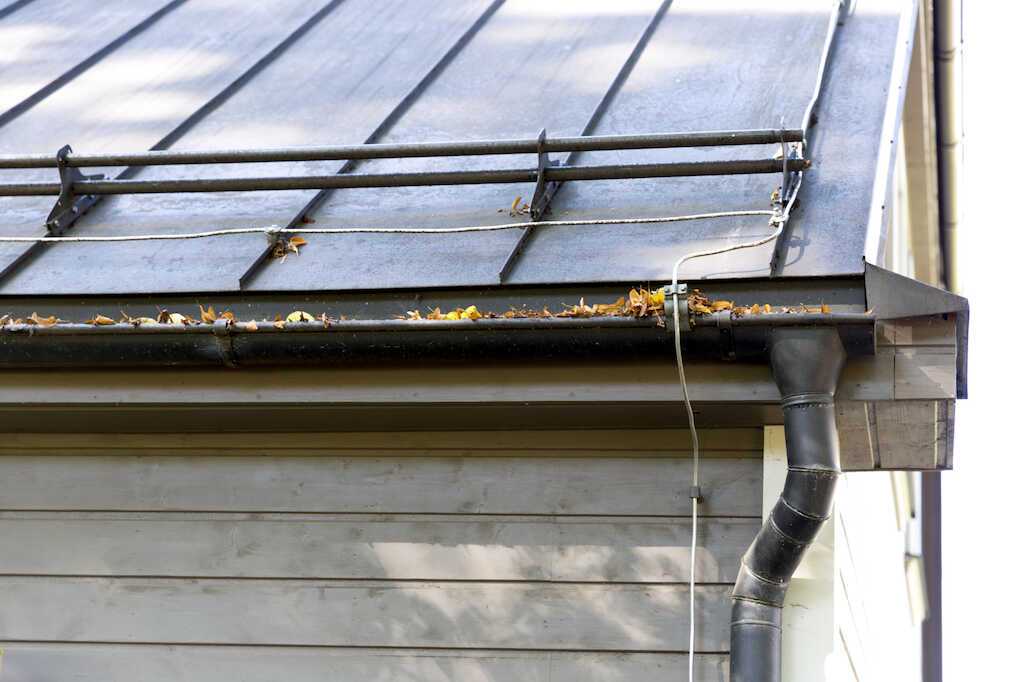Flat roofs have a long and storied history. They first rose to prominence around 4,000 BC in Mesopotamia. And they make total sense there – it’s a low-rainfall region.
Flat roofs are still popular today, but the climate of Illinois is a bit different. Springfield, IL, averages 37.43 inches of rainfall each year, plus around 22 inches of snow. So the burning question is, where does all that water go?
We’re going to explore everything you need to know about roof drainage. It’ll help you maintain your current roof or choose the best system for your next commercial roofing project.
Flat Roof Challenges
However well-designed they are, over time, flat roofs can become prone to ponding. Pools of standing water that fail to drain away can damage the membrane. The membrane may also deteriorate over time due to dirt in the rainwater and atmosphere and the effect of UV rays.
If there is any weakness in the joins, water can penetrate and start to degrade the roof’s substructure. In time, this can cause water ingress into the interior of your commercial premises.
Flat Roof Drainage Systems
In reality, no roof should be completely flat. All flat roofs require a slight gradient to encourage rainwater and snowmelt to flow toward some kind of outlet. Most businesses use one of three main flat roof drainage systems.
1. Scuppers
Flat roofs have a low wall that goes around the perimeter. This is called a parapet, and the rectangular openings in the wall for drainage are called scuppers.
Scuppers can be used with gutters to allow water to escape. The water then falls into a downpipe, channeling it away from the roof and foundation. The goal is to prevent ponding, which could damage the roof.
Scuppers need regular cleaning to prevent blockages. If they were to become clogged, water would quickly start ponding on the roof and causing damage.
2. Inner Drains
Inner drains work in a similar way to the drain in your shower. The roof is slightly sloped so that water gravitates toward a drain, typically located in the center of the roof. Pipes that run through the building’s roof then carry the water away and out of the building.
As every Illinois native will tell you, winters can be pretty harsh. Inner drains may help reduce problems with frozen pipes during the winter because the pipes are encased in the roof’s insulation.
3. Guttering Systems
Rain gutters are a tried and tested way of draining flat roofs. They direct water away from the flat roof by channeling it through downpipes and directing it away from the foundation of the building. It’s easy to understand how gutters work, but the challenge is keeping them clean.
They need constant attention. Otherwise, they will become clogged with dirt and debris. So even though they are a cost-effective choice when installing a new roof, it’s important to factor in the ongoing maintenance costs.
If they do become clogged, they can cause extensive damage to the roof, walls, and foundation.
What Are Siphonic Drainage Systems?
Siphonic drainage systems make guttering even more efficient. In a traditional downpipe, water and air enter the pipe. The air pushes the water to the edges of the pipe, reducing the volume of water that can be removed from the roof.
Siphonic drainage systems are much more efficient at draining water from roofs. They use a baffle plate to prevent air from entering the downpipe. This allows more water to drain away and reduces the likelihood of water ponding on the roof.
Another advantage is that you can use fewer downpipes, and they can have a more slender profile. This can improve both flat roof drainage and the aesthetics of your building.
How Crickets Aid Flat Roof Drainage
Another piece of flat roof drainage terminology to become familiar with is crickets. Crickets are structures built into the roof that help to prevent water from ponding by directing it toward the drains. They are typically triangular in shape and are made of insulation installed beneath the surface of the roof.
A roofing contractor can identify ‘danger areas’ on your roof where water could easily start ponding. This could include around the walls or HVAC units. Crickets can keep the water moving in the right direction,
Common Flat Roof Repairs
No matter how good your flat roof is, it will eventually require repairs. The most common reasons that problems occur include the following:
- Exposure – UV rays, rain, snow, hail, and ice all put pressure on roofing materials
- Ponding water – causes sagging and eventually breaches the roofing material
- Punctures – foot traffic and storms can cause punctures and tears
- Lack of maintenance – debris can build up, causing ponding and degradation of the roofing materials
Regular roof inspections and repairs can avoid or reduce many of these problems. A simple upgrade, such as recoating a roof, may add years to its lifespan. However, eventually, all roofs will need to be replaced.
Choose Williams Roofing for Flat Roof Repairs
Getting your commercial roof drainage right is the key to a roof that lasts for years. Any of the systems mentioned above can work well as long as they are correctly installed and maintained.
At Williams Roofing and Construction, we have been installing and repairing roofs for over 35 years. We focus on customer satisfaction. It all starts with a free roof inspection, followed by a no-obligation estimate for repairs or replacement.
Call us today at 217-636-8071 or reach out online.

